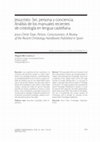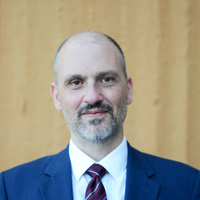Papers by Miguel Brugarolas

Gregory of Nazianzus and Gregory of Nyssa are situated in a complex historical and theological co... more Gregory of Nazianzus and Gregory of Nyssa are situated in a complex historical and theological context in terms of the development of their Christology. On the one hand, the Arian crisis demanded a clear explanation of the Logos’ perfect transcendence and, therefore, a vindication of the possibility of its Incarnation inasmuch as he is true God. On the other hand, the emergence of Apollinarianism unveiled the urgency of consider- ing all the consequences of the biblical teaching on the Incarnation of the Word and the authentic reality in every aspect of Christ’s humanity. In this context and in a time in which technical Christological language was not yet definitely configured, both Gregory of Nazianzus and Gregory of Nyssa describe the unity of the human and the divine in Christ using both paradox and ‘material’ categories, such as ‘mixture’ language. This article analyses some texts of the Cappadocian Fathers and it aims to show how their description of the relation between the human and the divine in Christ is grounded in an economic-salvific principle and points to an authentic pneumatological Christology. The Incarnation took place in such a manner that it is the only way through which human being can attain communion with God, an eschatological transformation described in apophatic terms.
Scripta Theologica, 2017
Gregory of Nyssa’s theology is profoundly Christocentric. This article delves into Gregory’s unde... more Gregory of Nyssa’s theology is profoundly Christocentric. This article delves into Gregory’s understanding of Christ’s mediation by analyzing some of his writings. Christ’s mediation is a key notion in the distinction between theologia and oikonomia. It also turns out to be essential in Gregory’s arguments concerning the Word’s divinity and the perfect humanity assumed in the Incarnation. Furthermore, the theology of mediation constitutes a key principle of Gregory’s spiritual doctrine and eschatology.

Gregory of Nyssa’s Christological language of mixture received a long criticism for its technical... more Gregory of Nyssa’s Christological language of mixture received a long criticism for its technical deficiency. However, despite its lack of precision and its limits, Gregory seems to use the language of mixture in a coherent way. From the perspective of the internal akolouthia of Gregory’s thought, his theological use of mixture vocabulary seems to refer to a kind of ineffable union closely related with two main principles of his doctrine: the infinite transcendence of God and his real presence through his econ- omy. The Christological sense of mixture is used in a way that, preserving God’s tran- scendence, represents an effort to avoid the deficient economy of salvation that is behind the conception of the Incarnation in both the Arian subordinationism and the Apolinarian Christology. This article deals, through the analysis of some selected texts, with the unity and distinction of theology and economy seen from the perspective of Gregory’s Christological language. Our aim is to point out that Gregory’s Christology, expressed on a non-technical vocabulary, bears an internal theological sense that is consistent with his wide comprehension of creation, restoration and spiritual life.
Scripta Theologica, 2023
This article explores the relationship between anthropology and Christology in the thought of Gre... more This article explores the relationship between anthropology and Christology in the thought of Gregory of Nyssa. On the basis of some texts of De hominis opificio, the correlation between the anthropological paradox and the Christological paradox is analyzed. The answer to the question, how can the human being, enveloped in evil, be the image of the one who has no relationship with evil, is given by the conspiracy of opposites in Christ: life comes through death and glory through the dishonor of the cross.
Bogoslovni vestnik, 2020
The lives of the saints are a true "hagiophany". Through them "God vividly manifests His presence... more The lives of the saints are a true "hagiophany". Through them "God vividly manifests His presence and His face to men" (LG 50). This paper deals with the relation between God and the human being as it is manifested in the notion of sanctity. It first stresses divine filiation as the right frame (by contrast with anthropocentric perspectives) to understand this relation and then reflects on the Christological character of holiness and martyrdom. From this perspective, the relation of the human being with God comes out with interesting nuances and reveals the close unity of ethos, worship and history that it involves. The saint bears in his ontological constitution the forma Christi.

in Nicu Dumitrascu (ed.), "The Ecumenical Legacy of the Cappadocians", Hampshire: Palgrave Macmillan, 2015, 247-263.
Gregory of Nyssa comments the text of John 17:22 in his homilies In canticum canticorum XV (GNO V... more Gregory of Nyssa comments the text of John 17:22 in his homilies In canticum canticorum XV (GNO VI 467,2-17) and In illud: Tunc et ipse filius (GNO III/2 21,19-22,16). In both texts he identifies the glory, which the Father gave to the Son and the Son gives to men, with the Holy Spirit. He affirms that the Spirit of Christ, which is ever contemplated together with the Son and the Father, is the Glory of Christ. Likewise, he reads in the same way the texts of John 12:28; 16:14-15 and 17:5.10, in order to stress the Trinitarian unity. Among the Divine Persons there is no distance since, as Gregory says, «all that the Father has the Son has, and all the goods of the Son are contemplated in the Spirit».
For Gregory, Christ glorifies his disciples by the sending of the Spirit, by giving them his own glory. Thus, the Holy Spirit is contemplated as the bond of unity both between the Father and the Son and between God and human beings.
In his works, Gregory uses the notion of Glory in different contexts and with a remarkable variety of meanings. Even so, the many references to the Holy Spirit as the Glory of the Son, which He receives from the Father and He communicates to his disciples, can be taken as an accurate expression of a well-defined pneumatological conception.
P. Gefaell (a cura di), Vir fidelis multum laudabitur. Nel centenario della nascita di Mons. Álvaro del Portillo, Vol. II, Roma: Edusc, 2014, 261-276.
El Concilio Vaticano II supuso una profunda comprensión del sacerdocio ministerial desde la persp... more El Concilio Vaticano II supuso una profunda comprensión del sacerdocio ministerial desde la perspectiva de la teología del ministerio apostólico y en su relación con la Iglesia como pueblo sacerdotal. Esta comunicación presenta las líneas fundamentales de la teología del sacerdocio de Álvaro del Portillo a partir de la esencial relación de consagración y misión. Ambas son inseparables, y en su unidad y en su orden –la consagración es teológicamente lo primero– convergen las dimensiones cristológica y eclesiológica del sacerdocio. La aportación de Álvaro del Portillo en este terreno brilla por su sincera y profunda comprensión del Concilio y por la vivencia fiel de su sacerdocio junto a San Josemaría
El amor a santa María de mons. Álvaro del Portillo y su profunda compenetración con san J osemarí... more El amor a santa María de mons. Álvaro del Portillo y su profunda compenetración con san J osemaría quedan particularmente expresados en su entrañable relación con el Santuario y la Virgen de Torreciudad. Estas páginas esbozan algunas de las enseñanzas de don Álvaro en Torreciudad, tomando como hilo conductor cinco homilías pronunciadas entre 1988 y 1992, tres de ellas sobre el sacerdocio, y otras dos más marcadamente marianas: en la Solemnidad de la Asunción y en el Año Mariano de 1988. Son textos sencillos y directos que tratan sobre los temas fundamentales de la vida y la doctrina cristiana, y que translucen una honda devoción mariana.
During the last decades important contributions to the re-reading of Thomas Aquinas' theology wer... more During the last decades important contributions to the re-reading of Thomas Aquinas' theology were done. This paper deals with those authors who made a greater effort to point out the deep unity and coherence of Thomas' thought from Trinitarian and Christological perspectives. Two remarkable issues of Thomas theology are stresed: the close unity between 'theology' and 'economy', and the theological approach to the mysteries of the life of Jesus Christ. Both of them are interconnected, since to contemplate the history of Jesus Christ as a true mystery -authentic presence of the True God- is a way to read the 'economy' in the 'theology'.
in J.E. RUTHERFORD (ed.), The Beauty of God's Presence in the Fathers of the Church. The Proceedings of the Eighth International Patristic Conference, Maynooth 2012, Four Court Press, Dublin 2014, 128-149.
Biblica et Patristica Thoruniensia 6 (2013) 149-165
Gregory of Nyssa makes clear reference to Job and the Book of Job in his works. Sometimes Job is ... more Gregory of Nyssa makes clear reference to Job and the Book of Job in his works. Sometimes Job is described as a great figure of the OT, full of virtues and imitable for his wisdom, his faith and his trust in God. In other instances, Gregory adduces the Book of Job when he deals with important theological issues like the origin of language or the descent of Christ into hell. This paper discusses Gregory’s exegesis of the Book of Job and points out both, his respect for the text and his high spiritual and theological comprehension of Scripture.

Las cuestiones del ser, la persona y la conciencia de Jesucristo ocupan un lugar importante en la... more Las cuestiones del ser, la persona y la conciencia de Jesucristo ocupan un lugar importante en la cristología moderna y contemporánea. La complejidad del tema en sí mismo y la gran cantidad de estudios que se han desarrollado hacen que no sea sencillo obtener una idea clara sobre el estado de la teología en este terreno. Este trabajo analiza y compara el modo en que los manuales recientes en lengua castellana se acercan a estos temas, cómo los explican y qué lugar ocupan en el conjunto de la cristología. El objetivo es penetrar en la situación actual de la cristología y ofrecer una visión panorámica de los manuales.
The issues about the "esse", the person and the consciousness of Jesus are strongly present in modern and contemporary Christology. Due to the complexity of the subject itself, and to the large number of studies dealing with it, is not easy to obtain a clear idea about the situation of Theology at this point. This paper analyses and compares the recent Christology Handbooks in Spanish, in order to examine their approach and their explanations about these issues within the whole of Christology. Our aim is to penetrate the current situation of Christology and to provide an overview of the present time Christology Handbooks.

Scripta de Maria II/X (2013) 55-73
PALABRAS CLAVE: San Gregario Nacianceno -Mariología -Cristología. RESUMEN: la mariología de san G... more PALABRAS CLAVE: San Gregario Nacianceno -Mariología -Cristología. RESUMEN: la mariología de san Gregario de Nacianzo está directamente relacionada con la verdad de la maternidad divina y con la verdad y perfección de la Humanidad del Señor. Por este motivo, la doctrina mariológica de Gregorio está estrechamente entrelazada con su cristología. Este artículo presenta la figura de santa María en el contexto de la cristología de Gregorio. En sus textos aparecen tres grandes temas: la Virginidad de María, como signo de la divinidad de Cristo; su Maternidad divina, como confesión de la verdad de la Encarnación del Verbo, y la "prepurificación" de santa María en su cuerpo y en su alma, como preparativo para su misión tan particular de ser la Madre del Salvador. De las enseñanzas de Gregario se desprende una gran profundidad teológica y una viva devoción mariana.
The theology of divine processions developed by Gregory of Nyssa in the last decades of the fourt... more The theology of divine processions developed by Gregory of Nyssa in the last decades of the fourth century was essential for the definitive statement of pneumatological dogma and for the overcoming of Trinitarian subordinationism. Following the path of Athanasius, Basil and Gregory of Nazianzus, Gregory of Nyssa explores the personal properties of the Holy Spirit, describing its origin in the Father "through" the Son. Its origin with respect to the Father and the "mediation" of the Son are for Gregory expression of both the personal distinction of the Spirit with respect to the Father and the Son, and the indissoluble union by which it is closely linked to them as divine Person.
Books by Miguel Brugarolas











Uploads
Papers by Miguel Brugarolas
For Gregory, Christ glorifies his disciples by the sending of the Spirit, by giving them his own glory. Thus, the Holy Spirit is contemplated as the bond of unity both between the Father and the Son and between God and human beings.
In his works, Gregory uses the notion of Glory in different contexts and with a remarkable variety of meanings. Even so, the many references to the Holy Spirit as the Glory of the Son, which He receives from the Father and He communicates to his disciples, can be taken as an accurate expression of a well-defined pneumatological conception.
The issues about the "esse", the person and the consciousness of Jesus are strongly present in modern and contemporary Christology. Due to the complexity of the subject itself, and to the large number of studies dealing with it, is not easy to obtain a clear idea about the situation of Theology at this point. This paper analyses and compares the recent Christology Handbooks in Spanish, in order to examine their approach and their explanations about these issues within the whole of Christology. Our aim is to penetrate the current situation of Christology and to provide an overview of the present time Christology Handbooks.
Books by Miguel Brugarolas
For Gregory, Christ glorifies his disciples by the sending of the Spirit, by giving them his own glory. Thus, the Holy Spirit is contemplated as the bond of unity both between the Father and the Son and between God and human beings.
In his works, Gregory uses the notion of Glory in different contexts and with a remarkable variety of meanings. Even so, the many references to the Holy Spirit as the Glory of the Son, which He receives from the Father and He communicates to his disciples, can be taken as an accurate expression of a well-defined pneumatological conception.
The issues about the "esse", the person and the consciousness of Jesus are strongly present in modern and contemporary Christology. Due to the complexity of the subject itself, and to the large number of studies dealing with it, is not easy to obtain a clear idea about the situation of Theology at this point. This paper analyses and compares the recent Christology Handbooks in Spanish, in order to examine their approach and their explanations about these issues within the whole of Christology. Our aim is to penetrate the current situation of Christology and to provide an overview of the present time Christology Handbooks.